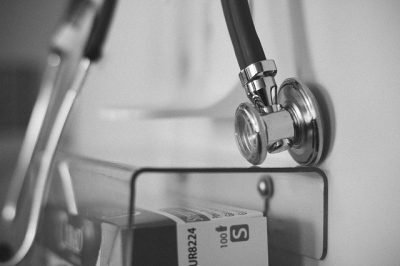 As a healthcare professional, if there’s one tool you’re guaranteed to be reaching for every single day you’re on duty, it’s your trusty stethoscope. Designed to pick up a range of sound frequencies and isolating them from external ambient noise so specialists can diagnose patients for further testing, stethoscopes play a direct role in helping prevent or alleviate the beginnings of cardiac or pulmonary conditions, and are an irreplaceable staple in a medical professional’s life.
As a healthcare professional, if there’s one tool you’re guaranteed to be reaching for every single day you’re on duty, it’s your trusty stethoscope. Designed to pick up a range of sound frequencies and isolating them from external ambient noise so specialists can diagnose patients for further testing, stethoscopes play a direct role in helping prevent or alleviate the beginnings of cardiac or pulmonary conditions, and are an irreplaceable staple in a medical professional’s life.
Considering their vital role in the medical field – and the wide range of healthcare professionals who use them, from EMT doctors and nurses to gynecologists, pediatricians and veterinarians – it’s important to make sure you’ve picked the right stethoscope for the job.
Where are you going to be using it?
Stethoscopes are built to amplify a range of high and low frequency sounds and isolate them from external noise so a specialist can gauge the condition of the heart and lungs. And how effectively it does this is partly dependent on where you’re going to be using it. If you work in an ambulance or as part of an emergency unit, the likelihood of a noisy environment makes listening out for these crucial cues, which can save lives depending on speedy and accurate diagnoses, more difficult. Many emergency health service workers use electronic stethoscopes, which can magnify the sounds picked up by the electromagnetic diaphragm and insulate them from external noises, so you can make precise and quick diagnoses on the spot.
 Since they’re a bit more on the expensive end, and are battery powered to boot, they are less justifiable when used in quieter environments, like a gynecologist’s office or pediatrician’s where you’d go for regular scheduled check-ups, and even in some cases for EMTs. Acoustic stethoscopes, provided you pick the right one, are perfectly capable of transferring a range of sound frequencies and amplifying them to be clearly discernible and distinct to the trained ear of a professional, some heavier duty options structured to enhance acoustic sound transmission and seal out external noise so effectively, doctors and emergency service providers often swear by the longevity and performance of acoustic options.
Since they’re a bit more on the expensive end, and are battery powered to boot, they are less justifiable when used in quieter environments, like a gynecologist’s office or pediatrician’s where you’d go for regular scheduled check-ups, and even in some cases for EMTs. Acoustic stethoscopes, provided you pick the right one, are perfectly capable of transferring a range of sound frequencies and amplifying them to be clearly discernible and distinct to the trained ear of a professional, some heavier duty options structured to enhance acoustic sound transmission and seal out external noise so effectively, doctors and emergency service providers often swear by the longevity and performance of acoustic options.
Picking a stethoscope for your field
 The stethoscope is a staple for any medical professional, but how it’s used and what features are the most vital for it to possess differ amongst the various subsets within said profession. For instance, pediatricians might opt for a stethoscope with a smaller diaphragm and bell, to pick up the much fainter sounds of heartbeats and breathing in children more effectively than a standard stethoscope. While incredibly useful to specialists mostly treating children, and in some cases for veterinarians who treat smaller animals, such a stethoscope wouldn’t serve as well for other applications.
The stethoscope is a staple for any medical professional, but how it’s used and what features are the most vital for it to possess differ amongst the various subsets within said profession. For instance, pediatricians might opt for a stethoscope with a smaller diaphragm and bell, to pick up the much fainter sounds of heartbeats and breathing in children more effectively than a standard stethoscope. While incredibly useful to specialists mostly treating children, and in some cases for veterinarians who treat smaller animals, such a stethoscope wouldn’t serve as well for other applications.
Similarly, the stethoscope used by a gynecologist to pick the faint sounds of an unborn baby’s heartbeat, through the mother’s womb, is purpose-built for this specific function and isn’t suited for use as a regular stethoscope. A fetal stethoscope replaces the typical dual-head chest piece with one that’s shaped a bit like a horn. The wider part, with the diaphragm, is pressed to the tummy of a pregnant mum, to transmit sound through the ear-pieces as a typical stethoscope will. A more simplistic design forgoes the tubing and earpieces altogether, featuring a trumpet shaped device called a Pinard horn or fetoscope, used a bit like an ear trumpet, with the diaphragm pressed to the mother’s stomach, and the doctor or nurse’s ear pressed to the other end.
In some cases, for instance if the mother experiences discomfort from the pressure of a fetal stethoscope, a Doppler stethoscope is used instead. Doppler stethoscopes are electronic devices which use the principle of the Doppler effect to convert ultrasound frequency waves to sound signals. Because of the higher sensitivity, Doppler stethoscopes are also used by EMTs and specialists, sometimes crucial in emergency scenarios since they can pick up fainter sounds, like subtle heartbeats, more clearly and accurately than regular or even cardiology stethoscopes can.
Speaking of cardiology stethoscopes – these, again, are stethoscopes better suited for certain applications over others. Working along the same lines as acoustic stethoscopes, cardiology stethoscopes feature tunable diaphragms you can tweak to zero into sounds of a varying range of frequencies. This makes them great for picking out any abnormalities in the functioning of your heart, such as arrhythmia and heart murmurs.
Features of a typical stethoscope
For the most part, stethoscopes come with the same components. Depending on your needs, you could opt for either a single- or dual-headed chest piece. If you’re a medical student or doctor in training, you’re most likely going to be using a dual-headed option, that’s to say a stethoscope with both a bell and a diaphragm. Breaking it down a little further, the flat metal disc of the diaphragm is better at picking up higher frequency sounds, while the bell end of the chest piece is better suited for picking up lower frequency sounds like heart murmurs. The diaphragm side of the chest piece needs more pressure to pick up sounds compared to the gentle touch appropriate for the bell side.
Contrarily, single-head stethoscopes combine the functionalities of both bell and diaphragm without you needing to flip the chest piece over when you’re switching between modes. Instead, alternating the pressure with which the diaphragm is held to the chest determines the frequency of sound it’ll be picking up. Depending on your needs and preferences, you can choose to go with the option that works best for you, since opinions tend to vary over which type is better.
Similarly, there is often a divorce in preference between users who prefer double lumens tubing versus single lumen tubing. Various factors, including your workplace and budget, come into play, but a point of consideration is that double wall tubing offers more sound insulation, making for better sound amplification and accurate diagnoses (and better in potentially noisy environments for sound isolation). Either way, the tubing directs the sound waves transmitted through the diaphragm which would otherwise have spread outward in one direction instead, through the binaurals to the earpieces.
When picking a stethoscope, ensure the earpieces are comfortable for you to have on, capable of sealing the sound in but also not being awkward to jam into your ears, and the leaf spring flexible to accommodate your head size – otherwise you might find it sitting too loosely, or being too tight. The earpieces should also be suitable for disinfection, and not prone to crumbling, breaking or cracking.
As medical equipment, stethoscopes must be FDA approved for safe use, but the types of materials and subsequent weight of your choice of stethoscope is up to you. If you want to go the bulletproof route despite the additional weight, we recommend the longevity of stainless steel and antimicrobial plastics. Lighter materials like aluminum and copper are also available, but if you’re looking for a tool for precise diagnoses to potentially last your whole career, stainless steel and titanium are both better at holding up from extensive use and better able to transfer sound. Also opt for latex-free tubing where possible, since some patients may be allergic to synthetic materials and plastics.